Jepp.
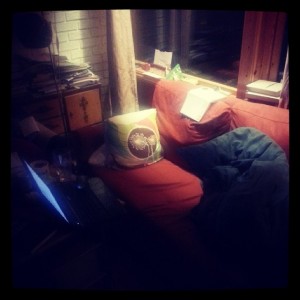 Her, i sofahjørnet, sitter jeg og skriver. Og leser. Dyna er på grunn av den nevnte forkjølelsen som ikke vil ta slutt.
Her, i sofahjørnet, sitter jeg og skriver. Og leser. Dyna er på grunn av den nevnte forkjølelsen som ikke vil ta slutt.
(Et bidrag i Onekligens bloggkalender.)
Jepp.
 Her, i sofahjørnet, sitter jeg og skriver. Og leser. Dyna er på grunn av den nevnte forkjølelsen som ikke vil ta slutt.
Her, i sofahjørnet, sitter jeg og skriver. Og leser. Dyna er på grunn av den nevnte forkjølelsen som ikke vil ta slutt.
(Et bidrag i Onekligens bloggkalender.)
(Det får heller se litt merkelig ut at alle innleggstitlene i januar er på svensk.)
Nå har jegforsåvidt mange bilder på mobilen som jeg liker bedre enn dette, men de er av ungene og de har jeg ikke tenkt å begynne å vise fram på bloggen, så dere får ta til takke med dette fra Solsiden i Trondheim, med en noe uklar fullmåne. Vakkert var det, selv om ikke mobilen var det beste kameraet å fange det med.
I’ve been taking a lot of pictures over the last few years, but the majority have involved the lass in some way. Now, of course, there is a lass mk2 as well (and yes, I have been taking a few pictures of her too). However, this does not mean that I don’t occasionally try to focus on the other sort of photography, the sort with fewer humans and more, well, attempts at “art” I suppose.
And as it happened I had a “free” afternoon on the day of the annual Scott Kelby Worldwide Photowalk – the fifth annual, I think – on the 13th of october. The maximum amount of fifty people had signed up for the walk in Trondheim, and quite a few thousand kroner worth of photographic equipment set off – with its owners – from “Blomsterbrua” toward Nyhavna, Lade and Svartlamoen.
I spent so much time messing about at Nyhavna that I didn’t make the rest of the route the organisers had planned, but there was so much to take pictures of that it hardly mattered. I left my camera on M for once, forcing myself to actually consider shutter and exposure time. You can see the whole set on Flickr. Some of the pictures I played around with in Photoshop, some I’ve left SOOC.
Here’s one I played around with…:
Whereas this is SOOC:
I had fun. And it was nice to meet such a lot of other local photography enthusiasts.
You can check out the pictures from the other participants in the WWPW Trondheim 2012 group on Flickr, and two other people have blogged about the event, Harald Wesenberg and Randi Aa.
Now all I need to do is figure out which picture I like the best and upload it to the photowalk page to take part in the competition.
Perhaps this one?
Not satisfied in ressurecting my book database, inviting a massive updating job, I’ve decided to change my image cataloguing software, too, opening a whole other can of worms.
Once upon a time I tagged my photos in Adobe Photoshop Elements. At some point I started digital scrapbooking and for some reason (partly because of the way PE worked), I decided I didn’t want to tag my digital supplies there, so I purchased ACDSee to handle that job. Which it did beautifully, as long as I bothered to put in the effort of tagging.
Then PE crashed. That is, it refused to start in catalogue mode (this is not what the mode is called, but I can’t remember the proper name) and if I started it in editing mode and tried to change over to catalogue it crashed. I searched for solutions online, and found several, nonoe of which worked. I was faced with doing a reinstall and a rebuild, and figured it would only mean putting myself at risk of the same thing happening again. I therefore decided to change over to ACDSee for photos as well, since it seemed to be working so well for digital supplies.
This was, oh, 3 years ago or so.
The last couple of years I’ve been increasingly tempted by Lightroom – especially because I’d like to learn to handle RAW files. And in August Adobe ran a pretty good promotion, offering Lightroom 3 at half off. So I purchased a licence, and I’ve been meaning to delve into it ever since.
Now, if I’m going to be using Lightroom for editing, it makes sense to have the catalogue there as well, no? Well, I thought so. And so I started testing out importing images. And that’s when I discovered a hitch.
See, ACDSee has this nifty menu option: “Write database info to files”, which I’ve been using regularly. However, it turns out it doesn’t write any info to the files that Lightroom can find. It seems (and I’ve only spent a very little time investigating, so correct me if I’m wrong) it only writes information in its own proprietary format. So, yes, you could resurrect your ACDSee database based on it, but you can’t import it into another program.
Why?
I mean, I can see that it would make the threshold for changing to other software higher if you should find out about it while considering a change, but as I’d already made that decision, it only made me determined to change as soon as possible so as to not waste more effort. And had I known before I started using ACDSee, I would probably have searched for another solution entirely and NOT purchased the software. And I’m unlikely to recommend it to anyone else now – which I would have otherwise, it works well and has a gentler learning curve for amateurs than Lightroom. Oh, and it’s cheaper.
Anyway. I just landed myself with three years’ worth of photos to tag. Sigh. However, I’d rather make the effort now. Portability is pretty important to me, and when the lass decides to unearth her mother’s photograph collection from that dusty old drive in the attic (or from the cloud or wherever we will be storing such things in the future), I want the image data to be readable to her, and the best way of ensuring that is to get it written to the standardised EXIF/XMP, not some proprietary format thingamabob.
I seem to remember promising to post something about the Gambia photobook once I’d received the finished product. Which I did a couple of weeks ago. And I finally got around to taking pictures of it in daylight last week. So. Here goes, prepare for rather a lot of images:
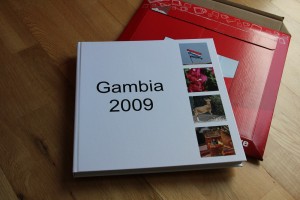
I sort of forgot that I needed a cover. So I ended up just pulling out four random images that I’d not had occasion to use inside the book and plopping them into the spots suggested by the default layout. With hindsight I should have spent a bit more time investigating the options, I’d probably have preferred another base colour than white, for example, but it works, and I guess that’s the important thing.
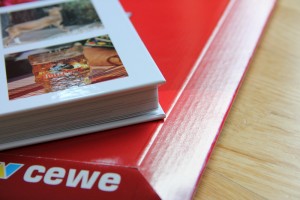
I ended up with close on 80 pages, and it’s printed on photo paper which makes it even thicker. However, it’s slimmer than I feared, I was a bit worried that it would be so thick as to be unmanageable, but it’s not. Far from it. It feels hefty and lovely, but is not so heavy that you need a reading table.
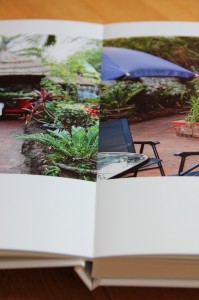
Another benefit of the photo paper version: The two facing pages are actually printed on one large sheet, and the sheets are glued back to back to create the book. This means that the book opens completely and no part of the page is lost “in the crease”.
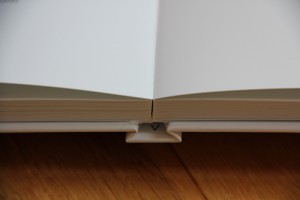
It also lies flat on the table (or floor in this case). No need to hold it open.
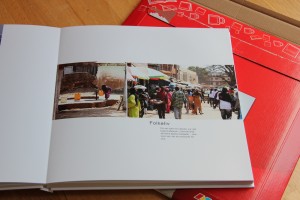
I’m normally more of a maximalist than a minimalist, but just when it comes to photos I find I like as little noise as possible around them. I considered serveral design options for this album, and was planning, at the very least, to choose a colour scheme that I’d use for a few frames, titles and brush swirls. But once I started pulling together the pictures, I realised they worked so well on their own that embellishment would distract rather than add, so I discarded the idea.
The one digital scrapbboking supply I used was a set of templates called “Off to Press” by Paislee Press, available at Oscraps. The templates are for an 8×10 album, so I’ve gone through them and resized them to 12×12. I’ve also moved photo and text spots around a bit on quite a few of the pages, as well as resizing or even duplicating photo spots as needed. I really love this template set, as it helped me keep the look reasonably consistent and encouraging copious amounts of white space while being simple enough to be exceedingly flexible.
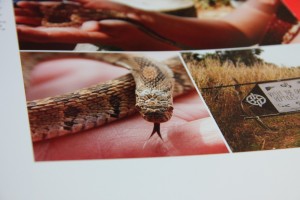
I’m really glad that I went for the photo paper option and didn’t fall for the temptation to save a few kroner by choosing a less expensive format. The clarity is really outstanding, any blur in the images is my fault entirely.
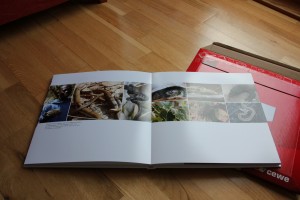
The other supply I used was a couple of actions from Pioneer Woman’s free action sets. Every image has had either “Boost” or “Define and sharpen” run on it, though on some I’ve reduced the opacity of the action layer(s) to avoid an overly processed look. In a few cases I’ve also used “Slight lighten”. Actions are a great way to get quick results for us lazy people, and I don’t think I’d have been able to finish the album on time without them.
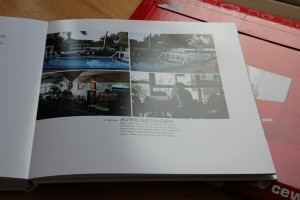
I normally date all my digital pages (with the date of the photos/subject, not date of creation), but since this is a cohesive album of one week’s trip, I only kept the date on the first page for each day.
All in all, I’m really thrilled with how this turned out. I had a serious attack of “Squee!” when I unwrapped this. The book, by the way, is printed at Japan Photo, who use a system called CEWE, which I suspect is available through other chains in Europe also, though I don’t know for certain.
Now all I have to do is get all my other photos into proper photo books. Yup. Well, one step at a time…
I’ve been drooling over instant cameras for some time. I was on the verge of buying a polaroid camera off ebay when it was announced that film would no longer be produced and I decided against it. Then the Fuji Instax appeared and started making the rounds in the blogosphere. It’s ages since I decided to buy one, I just haven’t gotten round to it, mainly because it’s not available in Norway (don’t ask me why, I have no idea).
So when we were in Dublin last weekend, I knew I had to grab my chance. I’d found one retailer on the net that appeared to stock it, so off to John Gunn we went. I’d planned on getting the mini, but they were out, and also claimed that it was being discontinued. I don’t know whether that is true or not, but it doesn’t matter much, I got the Instax 200 instead, and I’m quite happy with that.
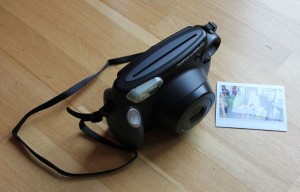
The pictures are about twice the size as the ones from the mini, which is a plus in most situations, and I fell badly for the look. The woman who helped me in the shop had one herself and she said it always gets a laugh when she brings it out. I can imagine, it’s humongous and also looks like a toy camera, and she was a petite lady of at least 50 years of age. “They laugh and then they steal your prints,” she claimed, and I can well belive it.
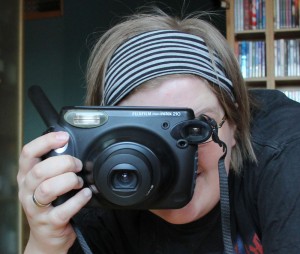
I haven’t really had time to play much with it yet, but I did buy quite a lot of film, so I’m all set. This weekend, perhaps?
I’m feeling a sense of accomplishment today. Before Christmas I received a promotional code for a photo book on photo paper from Japan Photo, and after a little deliberation decided it would be the perfect incentive to finish the very half-hearted start I’d done on an album from the trip to The Gambia in 2009. The promotion ended yesterday, and the album was ordered just in time. Considering I have a tendency to attack these projects with gusto and then have my enthusiasm fade away long before I’ve actually finished anything, having ordered the book feels like a big accomplishment.
Which is nice.
The best thing? I managed to pace myself sufficiently that I’m not sick of looking at and processing photos. The previous photo books I’ve ordered have led to a few moths hiatus on further layouts because of overload towards the finishing line. Not so this time, I think.
Once I get the book, I’ll post a few pictures of the result and get into what exactly I did. In terms of scrapbooking it was extremely minimalist, but a couple of resources need to be mentioned. I’ll get to that.
The next project, apart from finishing the hobby room (where we’ve run into a little problem, more on that later) involves the sewing machine and needs to be done by the end of the upcoming weekend. We’ll see how that goes.
The next photo-related project involves going through my supplies to create a faux Project Life (because I really don’t need to buy any more supplies) to see if I can’t get a “document life as it happens” thing going. If I get my act together, I’ll share what I do.